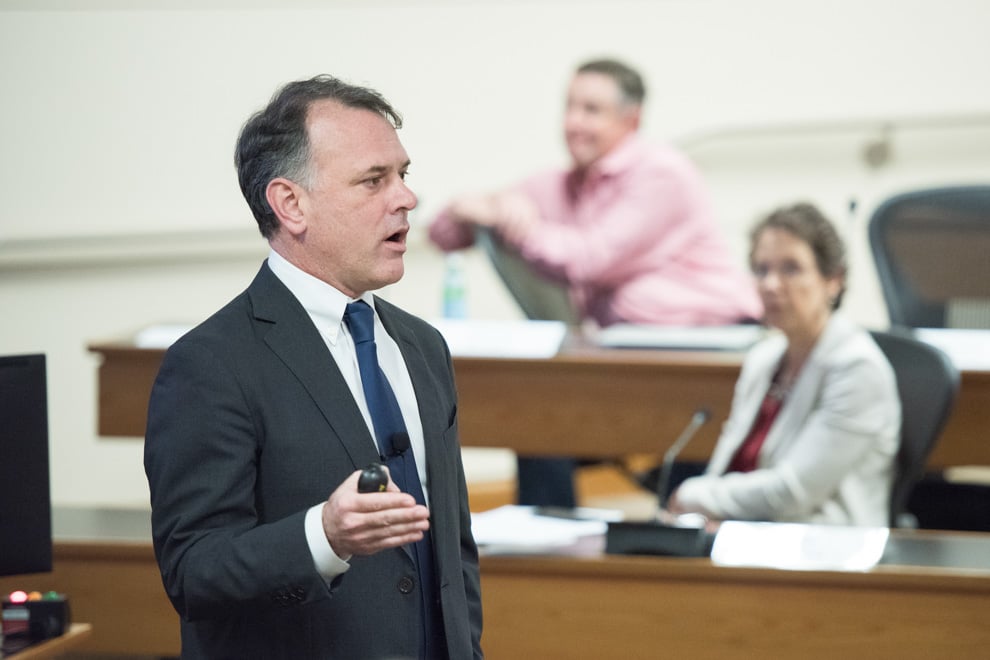In its last meeting of winter quarter, the Faculty Senate considered the Stanford Management Company’s (SMC) investment practices and usage of the Stanford name and emblem.
SMC Chief Executive Officer Robert Wallace came to the Faculty Senate on Thursday to report on the workings of the SMC and clarify the SMC’s position on issues such as divestment.
Wallace spoke of the SMC’s role as fiduciary of Stanford’s $26.9 billion merged pool of total investments. He also explained the SMC’s dual goals of supporting the University’s expenditures while maintaining the purchasing power of its endowment. Referring to Stanford’s annual operating budget of $1.2 billion, Wallace noted that a nine percent annualized nominal return was necessary in order to account for spending and inflation.
Wallace also highlighted the SMC’s performance, showing that it had, in the 26-year period between 1991 and 2017, outperformed median college and university endowment investment returns by roughly 100 percent. In the 12 months ending in June 2017, the SMC generated a 13.1 percent net investment return. He also explained the distribution of asset classes in the SMC’s portfolio, which include a large proportion of absolute return and international and private equity.
In the context of current calls for divestment from student groups, Wallace said that the SMC’s divestment policy is currently under review by Stanford’s Board of Trustees.
“The endowment is not a tool for social activism,” Wallace said in response to a question from biology professor Susan McConnell about how the SMC determines ethical investment. “We at the Stanford Management Company do not believe it is our job to try to achieve particular social outcomes unless they are consistent with our direct divestment policy or our long-term economic goals.”
Civil and environmental engineering professor Jeffrey Koseff also posed a question about whether the SMC should make use of Stanford’s economic resources to be a positive agent for social change.
“I think the capital we deploy in the world does really good things in the world … because we are so focused on long-term results and because we are so careful about who we work with and [the companies we work with are] so careful about the companies that they invest in,” Wallace responded. “when there’s a problem, we fix it.”
Regarding investment transparency, Wallace stated that the SMC maintains full transparency with its Board of Directors. The SMC’s Board of Directors is determined by the Board of Trustees and includes President Marc Tessier-Lavigne.
ASSU Senator Aamnah Khalid ’20 followed up with a question about why the SMC does not make its operations transparent to the public.
“When [the SMC] finds opportunities … they’re often very capacity-constrained [and] very competitive,” Wallace said. “If we just tell everybody in the world what we’re doing, then our competitive edge will erode.”
Wallace also clarified the legality of SMC’s offshore investment practices, emphasizing that Stanford has “a fiduciary obligation within the law to mitigate taxes, not evade taxes.”
“[The SMC does] not use offshore vehicles like the criminal world uses them,” he said. “When we use offshore vehicles, they are fully reported to the Internal Revenue Service … we’re not operating in an aggressive area in the tax code — it’s not a grey area.”
The Faculty Senate also saw a presentation on preserving the integrity of the use of Stanford’s name and emblem. Vice President for University Communication Lisa Lapin, Senior Director of University Brand Management Nicole Scandlyn and Assistant Vice President for Business Development Susan Weinstein, discussed the regulations in place regarding Stanford’s brand in addition to cases of its misuse.
The presenters highlighted many specific instances where private entities used Stanford’s brand without following proper procedure or receiving permission.
“When you see film crews on campus that look suspicious, it’s fine to call [the Office of University Communications],” Lapin said in reference to a recent case of a film crew operating without proper permission in the McMurtry Building.
The presenters also emphasized Stanford’s general aversion to associating its brand with corporate and commercial material.
“The University name and logo are allowed to be used by any organization that’s officially sanctioned by Stanford,” Weinstein said.
Contact Sean Chen at kxsean ‘at’ stanford.edu.
